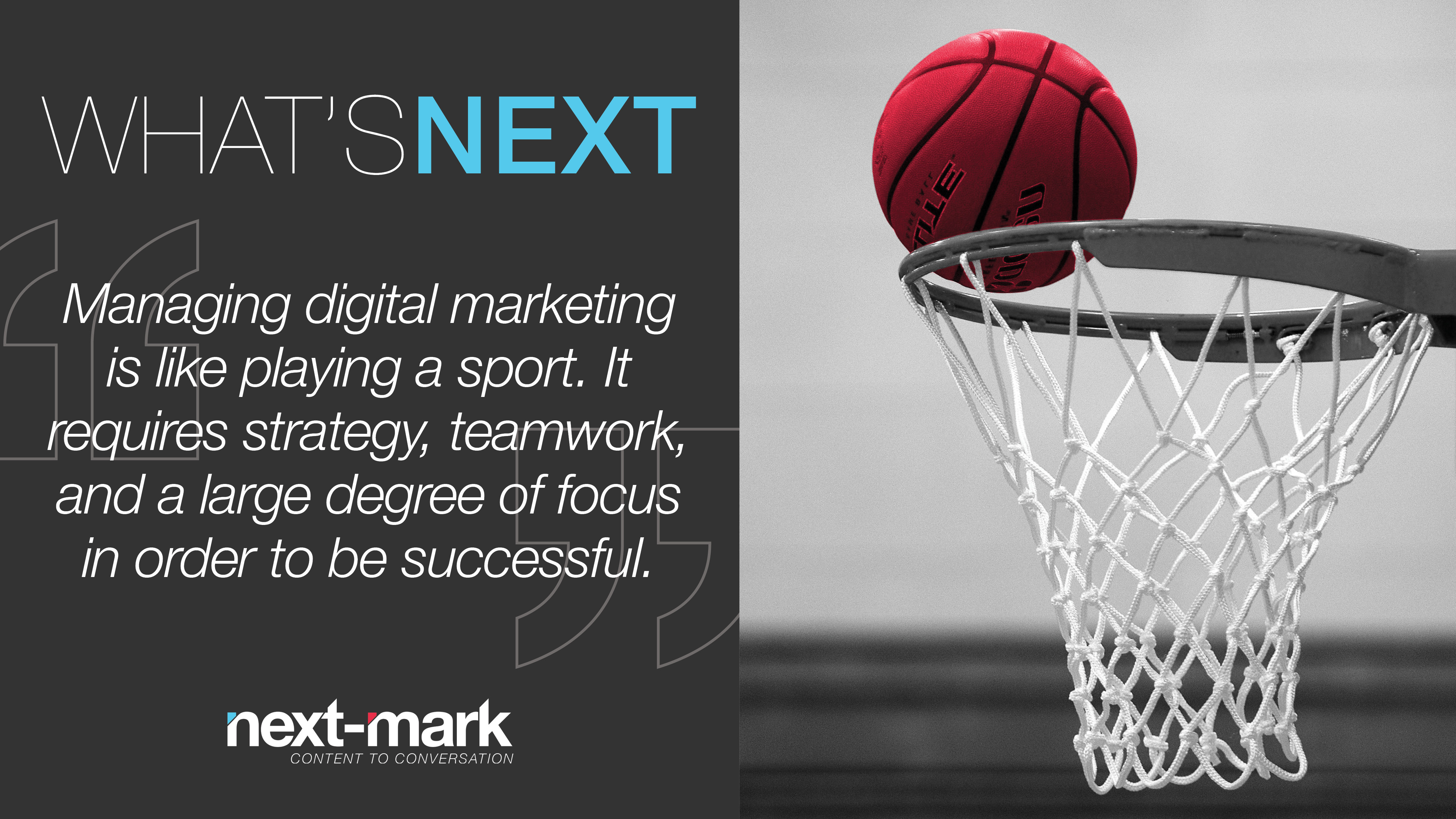



In 2018’s Fortune 500 list of CEOs, only 24 were women – a noticeable decrease from the year prior. With women representing only a small percentage of corporate leaders, their presence is scrutinized both by people hoping to emulate their path to success and by naysayers who wish to disregard their presence. In honor of International Women’s Day, let’s explore the leadership styles of a few of the top female business leaders to learn what makes them successful communicators.
Former president and editor-in-chief of The Huffington Post Media Group, Arianna Huffington is now the CEO of Thrive Global. The company runs a digital platform dedicated to helping people avoid emotional, physical and mental burnout. Huffington’s style of corporate communication is authentic, direct and candid. This approach directly aligns with her company’s values, so whether she’s speaking to a crowd or sharing her life on her many social media channels her message is always consistent and memorable.
Chairman and CEO of PepsiCo, Indra Nooyi helped grow the company’s revenue from $35 billion in 2006 to $63.5 billion in 2017. Nooyi is known for her visionary leadership style, which includes navigating PepsiCo through a changing market and an impending financial crisis. For Nooyi, communication is key. She outlines exactly what performance is needed to boost the company’s portfolio at every stage of the process, then honestly and directly addresses any concerns. Her passion, conviction and clear communication continues to be successful, leading to a total shareholder return of 162 percent.
Arguably one of the most well-known female leaders of our time, Sheryl Sandberg is a master communicator. “The ability to listen is as important as the ability to speak,” she famously said. When Sandberg began her position at Facebook, she met hundreds of employees and encouraged them to share their insights and thoughts about the company. Sandberg is no stranger to the spotlight, from best-selling book “Lean In” to a TED talk that has received millions of views. No matter the topic or platform, her speaking style is simple and filled with personal stories to help her connect with her audience. She is seen as an approachable, respected and strong leader.
A clear corporate communication strategy is key successful leadership. Whether you run a small business based here in Sarasota or you’re in charge of an international organization, great leaders can help motivate teams, shape company messaging and inspire change. Align your leadership strategy with a powerful marketing plan – give us a call to get started.
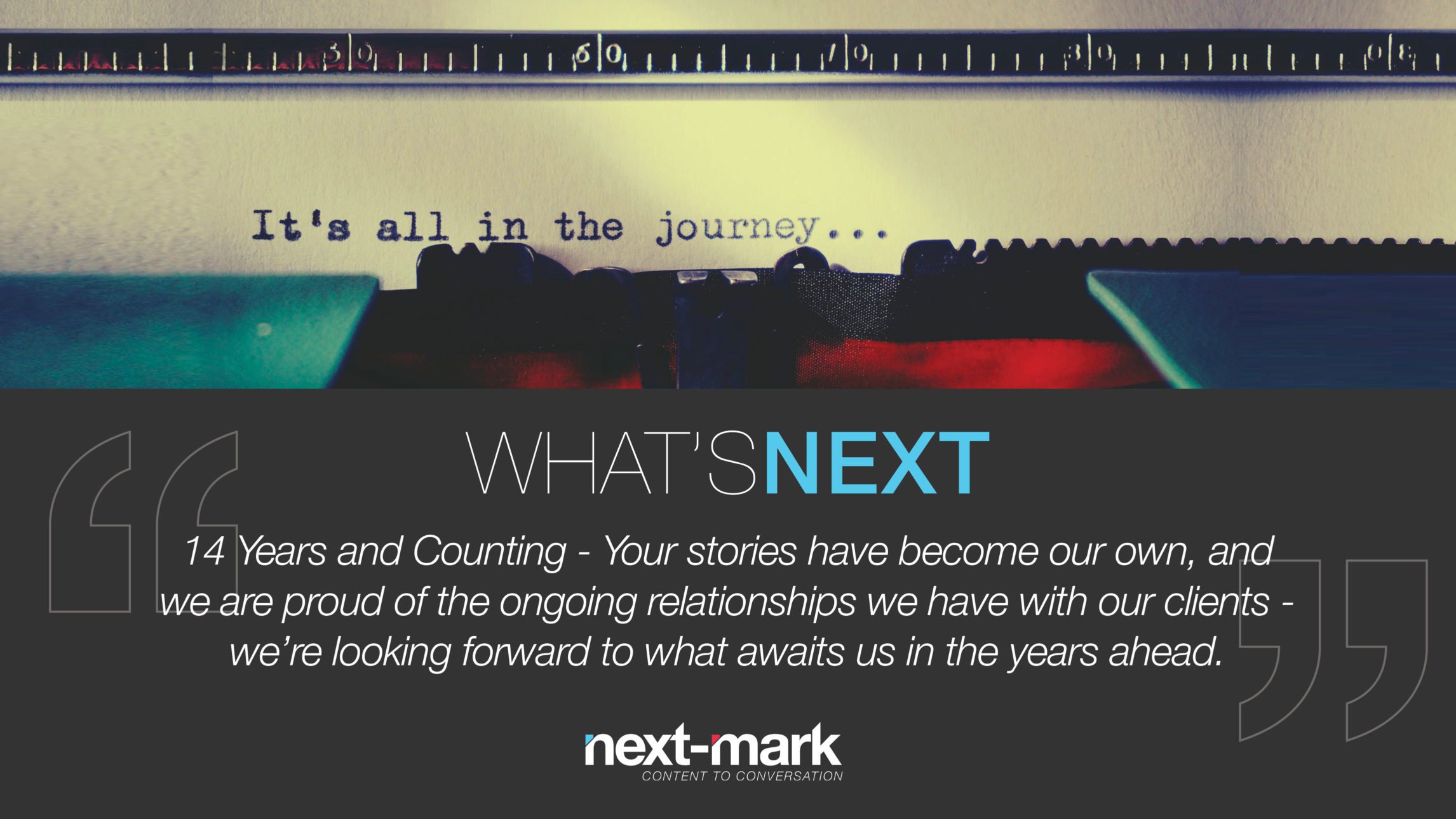
As we embark on our 15th year in business, it’s hard to believe the incredible journey we’ve been on – and how far it has taken us. I am incredibly grateful to our team members, our clients and the many others who supported Next-Mark as it has grown and evolved in this ever-evolving marketing environment.
It’s been an extraordinary experience, which literally has taken us around the world, from hosting clients from Sweden, to holding conference calls with clients in Dubai, to creating communications plans for Sarasota neighbors just a few miles down the road. From developing marketing strategies for international corporations to local sole proprietors, we have helped numerous companies create conversations about their brands and tell their stories. Their stories have become our own, and we are proud of the ongoing relationships we have with our clients and within our community.
While we’re excited to see what’s next, we know some things will remain steadfast, especially our core beliefs and values, which guide us to:
Although we definitely are proud of what we’ve accomplished, we know we didn’t do it alone. Again, we are sincerely thankful for all who helped us get to where we are and excited to continue those relationships while building new ones.
We’re looking forward to what awaits us in the years ahead. If you would like to engage with us, let us know. We are ready and eager to help.

Many viewers of Super Bowl 53 had the same overall impression – meh. The game was low-scoring, the ads weren’t altogether revolutionary, and the halftime performance led to quite a few not-so-kind memes online. And, as happens every year in the advertising world, many wondered whether the $5 million per 30 second commercial price tag was really worth the air time. Some traditional heavy hitters (we’re looking at you Doritos) took the plunge, while others opted for a more digitally focused campaign that utilized social media to reach audiences. Here are a few commercials that stood out in our minds, for better or for worse.
Most Timely:
Coke’s theme of unity and celebrating our differences was classic and appropriate for today’s volatile social environment. Opting for illustrations distinct from its typical commercials, Coke stood out from the crowd by echoing the company’s core values. However, while it was a winner all around, other ads generated more buzz online.
Trendiest:
Had you aired the Zoë Kravitz ASMR for Michelob ULTRA commercial just a few years ago, viewers would have been left hopelessly confused. ASMR is a popular style of content on YouTube but, like most trends online, probably won’t be around for too long. Thus, this quirky ad probably won’t have the staying power of other commercials.
Most Forgettable:
Yawn. The Pringles’ commercial utilizing an Alexa-type device fell flat. The concept of mixing flavors is old news for the company and was a neutral, yet too safe a bet for the brand. The ad was easily overshadowed by other brands that opted for bolder choices.
Funniest:
Olay’s #KillerSkin ad featuring Sarah Michelle Gellar was a winner. Memorable, amusing and timely, this commercial has people in the industry talking. We love that the “story” can easily be translated to the online space and even extended to feature other situations as needed. It was also one of the few that included an easy-to-remember hashtag for quick sharing.
Most Star-Studded:
Pepsi went for star power with Steve Carell, Cardi B and Lil Jon in its “More than OK” ad. We shudder to think about the cost of the ad and, from our perspective, we’re not sure the price tag was worth the output. The commercial seemed a little too crowded and is the brand association with the word “OK” really beneficial? Another direction may have been a little more effective. Try again next year Pepsi.
Best Overall:
Bud Light once again didn’t fail to disappoint with its “Special Delivery” ad that soundly dissed its competitors’ use of high fructose corn syrup. It was humorous, well-branded and lit up the Twitter-verse. While the companies Bud Light called out attempted to respond online, their voices were drowned out by the loud praise for the commercial.
What did you think about this year’s lineup?
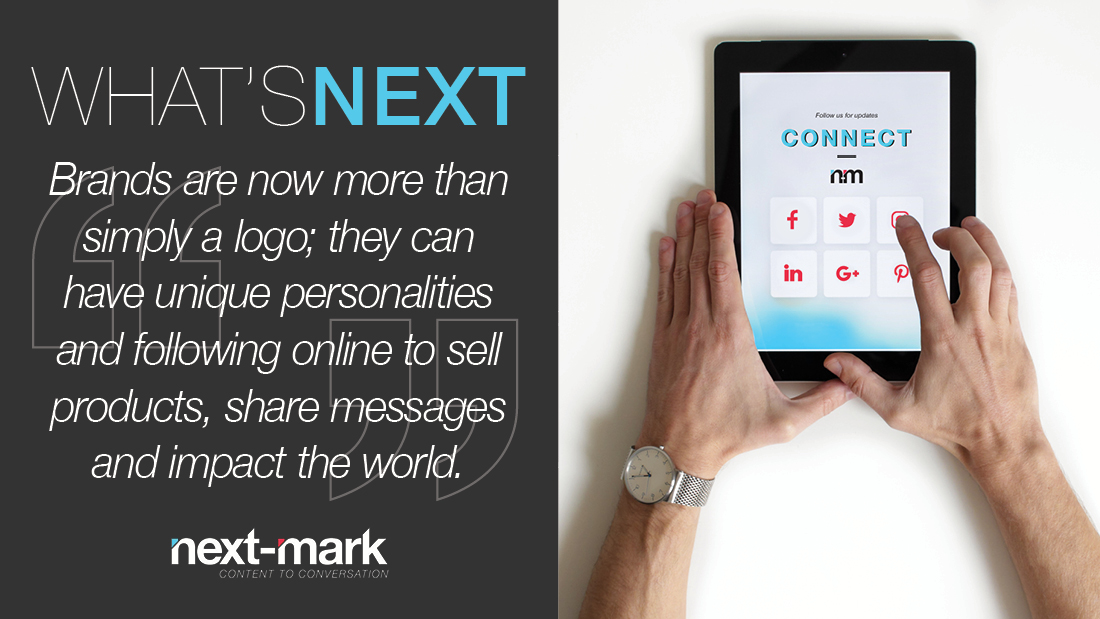
As we dive into 2019, one thing is for certain: Social media is here to stay. While channels will continue to evolve and change, digital mediums are now infused into our social fabric. Although the negative aspects of sharing online will forever be debated, individuals rely on social media for news, engagement, suggestions, insights, connection and just plain fun.
Roughly two-thirds of all adults use Facebook, and an even greater number are streaming video content on YouTube. Newer channels like Instagram, Snapchat and others are also growing in popularity. Many companies have embraced this societal frontier and utilize it to successfully reach target audiences. Brands are now more than simply a logo on a billboard; they can develop unique personalities and followings online to sell products, share messages and impact the world.
Is your organization still new to social media? Here are some best practices to follow:
Be authentic:
Paid promotions and reviews are permeating social media, causing many audiences to mistrust companies online. Make sure interactions are sincere and any purchased product placements are disclosed. Your organization’s core values need to be reflected online.
Find your unique brand voice:
Quirky, cool, or educational – whatever voice you choose for your online brand, make sure it’s consistent. Audiences should be able to identify your content as distinct to your organization. Be sure to refine your messaging to reflect this consistency.
Take an innovative approach:
Distinguish your company from its competition by taking a fresh approach to its online presence. Just because something worked for a similar organization, doesn’t mean that it will (or should) work for your brand.
Be consistent with aesthetics:
As simple as it may seem, one of the factors that distinguishes a successful company from one that gets less engagement is look-and-feel. Choose colors, types of content and imagery in advance to make sure it’s a cohesive, branded visual. The goal is to have audiences view your content on different channels and know it came from your company.
Find the right medium:
Not every social media channel will be the right fit for every organization. Find suitable mediums based on the content you’ll be sharing, your target demographic and the amount of time required for successful implementation on each platform.
The bottom line:
Companies who are resistant to a digital presence are losing out on valuable customer interaction. Employ a strategic, comprehensive approach to best utilize social media platforms and you’ll see your company’s presence surge!
Is social media the next step for your company? Give us a call – we would love to share our insights at 941.544.2765. For more information on our capabilities, view our Online LookBook.
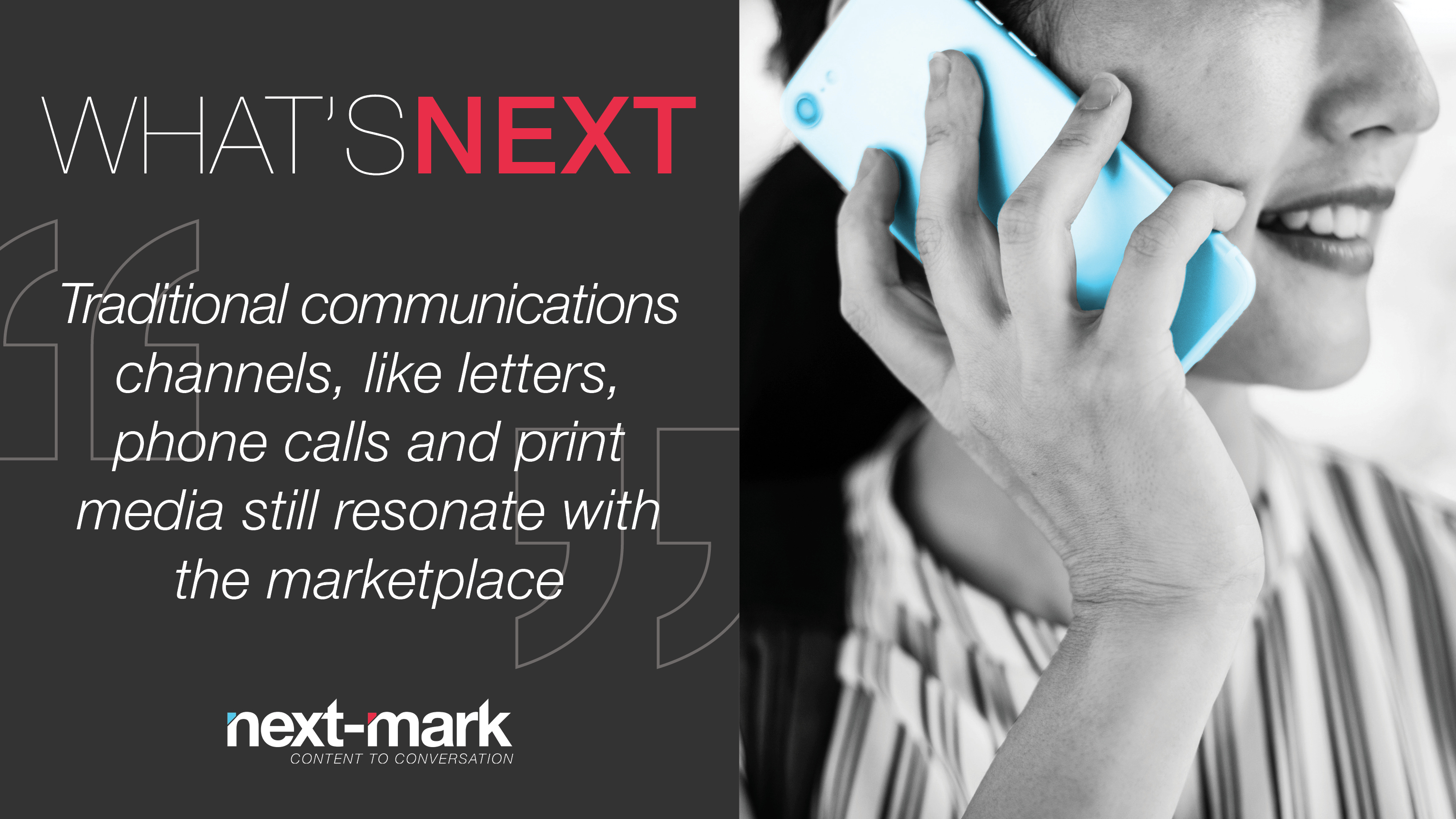
While digital strategy is a crucial part of most comprehensive communications campaigns, it’s important for marketing professionals to recognize that “traditional” mediums certainly can still be effective. Before we dive into why we think you shouldn’t ignore traditional media, let’s review the distinction between the two:
Traditional Communication Channels – Think magazines, newspapers, phone calls, brochures & other print collateral, guerrilla marketing, billboards, as well as good ol’ fashioned broadcast media.
Digital Communication Channels – This category encompasses any online activity including social media & other apps, websites, display advertising, e-newsletters, affiliate marketing and many more! Online communication continues to evolve and expand as more digital mediums are created.
Now, let’s explore the top two reasons why traditional mediums can help you share your message and reach your audiences.
1. Add a personal touch
As more and more advertisers are paying for online placement, opinions and reviews, audiences have become masters at recognizing when content isn’t authentic. Companies that personally connect with their customers are getting noticed. For example, when the new president at the University of Florida was hired, he went above and beyond to show students that the university cares about their well being. He’s been known to buy students Starbucks drinks during finals week and photo bomb graduation photos. These interactions were often shared online, but the interaction with students displayed a sense of authenticity often lost to many organizations. In the New Year, try to reach out to your audiences through a traditional channel – write a letter wishing your clients the best in 2019 or pick up the phone and give them a quick call to say you’re grateful for their business.
2. Go with a trusted source
While channels like Instagram and YouTube certainly boast impressive reach, traditional media is still viewed as an essential source for fact-based information. A recent Pew Research Center survey showed that 47% of Americans still prefer watching the news rather than listening or reading it. Considering how many online articles rely on shock value headlines to garner clicks with little if any valuable content, it’s no wonder that many people still turn on their television! Thus, targeted TV interviews, advertisements and other broadcast media outreach can still be strategic, as least for the time being.
As always, keep in mind that every tactic should fit into a larger communications plan! A combination of both traditional and “new” media is generally the best route. If you need help figuring out the best way to reach your audiences, give us a call.
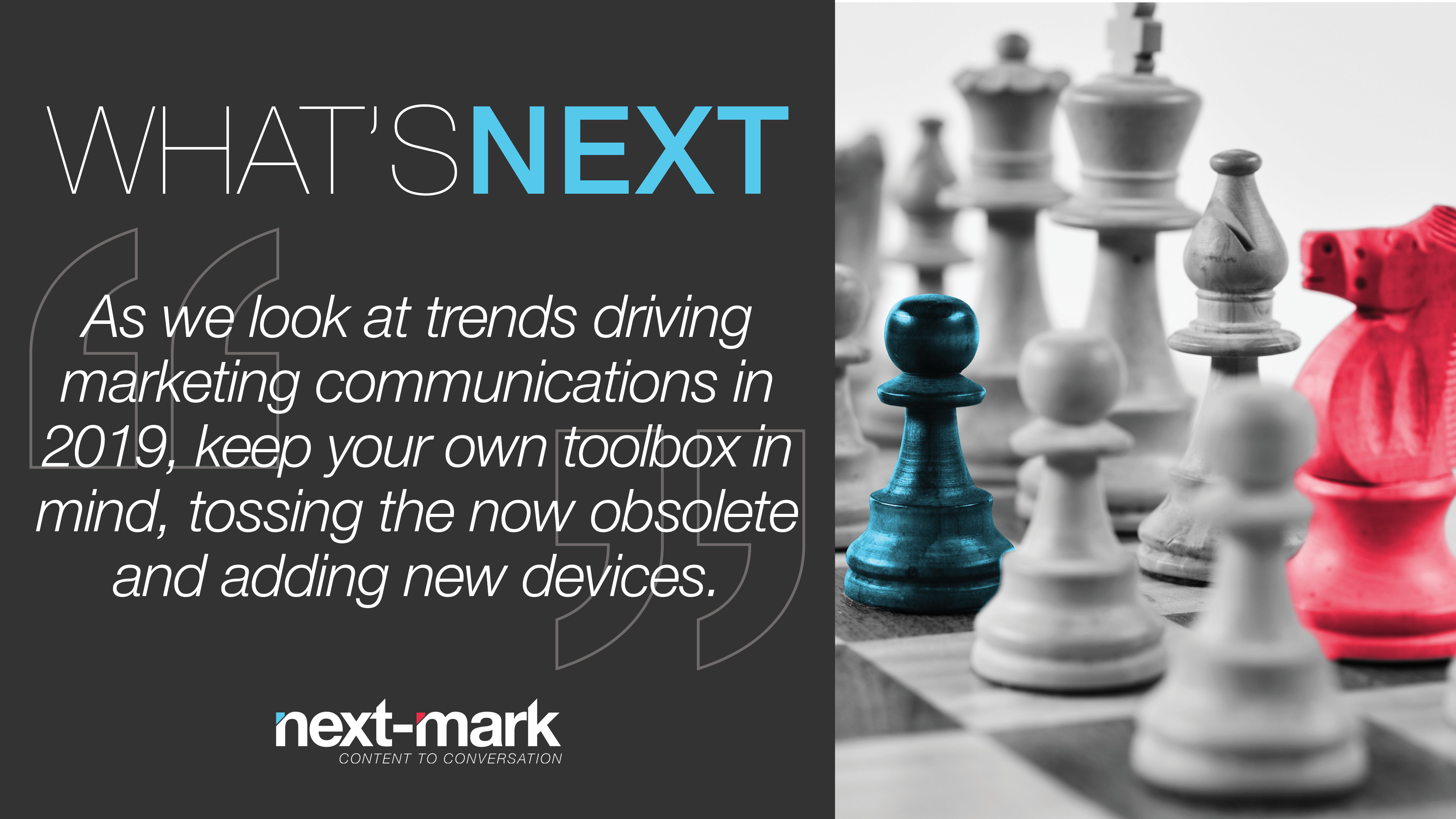
Planning is critical in any business. In marketing, it’s also important to have the right tools in place to transform plans into a solid strategy with tactics that propel your business forward. So, as we look at trends driving marketing communications in 2019, keep your own toolbox in mind, tossing the now obsolete and adding new devices.
1. Refreshing Your Brand: Self-Evaluation
One of the key ways we serve our clients is by helping them to understand their brand – as it was, is and should be. While we’ve been doing this for years, experts report that this concept is taking a stronger hold recently, especially in the B2B realm. The process involves creating or re-evaluating the core brand promise and developing a messaging strategy that demonstrates what that company is today. It’s an inward look at what the rest of the world sees and, from our experience, it can be quite eye-opening.
2. Marketing in the Palm of Your Hand Social Media Still Reigns
Social networking apps have become one of marketing’s most powerful forms of outreach for both content and advertising. Offering a fast track to customer engagement and brand loyalty, apps like Instagram also promise an attractive ROI. Though a simple process, presence on these networks does require a high degree of creativity to draw attention, maintain contact and engage with followers. Strategic planning to grow a profile’s following is also a necessity. In 2019, we can expect to see newer apps like Vero burst onto the scene and potentially dethrone some of the powerhouse social media mediums that have dominated the market this year.
3. Embracing Influencer Marketing: Authenticity is a Priority
Social media is by far the most popular channel for Influencer Marketing, which entails building relationships with others who can connect you to your target market. An influencer is simply someone who has a large following on social media and other digital platforms, and can affect the purchasing decisions of their fans. Seen to be a perfect tool for today’s ad-weary consumers, Influencer Marketing can add authenticity to brand communications and strategy. We predict that companies in the New Year will focus less on simply the number of followers an influencer has, and more on whether the individual is a good fit for the brand and campaign. Veracity will always be valued be social media consumers.
4. Focusing on The Few: Account-Based Marketing
Account-Based Marketing concentrates resources and effort on a limited set of carefully chosen target accounts, and has brought a personal touch to business-to-business (B2B) marketing. Based on the needs of each individual prospect or customer in that set, Account-Based Marketing drives customized campaigns designed to speak specifically to them. Admittedly, it’s harder than sending a blast email. However, reports show that nearly 85 percent of marketers measuring ROI say that Account-Based Marketing outperforms other marketing spends – and 50 percent say the difference is significant.
5. Seeing is Believing: Video Will Continue to Grow and Flourish
Video content, which currently makes up 75 percent of internet traffic, is expected to grow to a whopping 82 percent by 2021, according to Cisco’s annual Visual Network Index forecast. A powerful tool in story telling, motivating, entertaining and relationship building, video is poised to continue dominating digital marketing. Here, again and of course, creativity is essential, as the point isn’t just to sell but to create bonds that last.
What Else is on the Horizon?
While we’ll stop here, there are few other things to put on your “watch” list as 2019 brings another year of business opportunity.
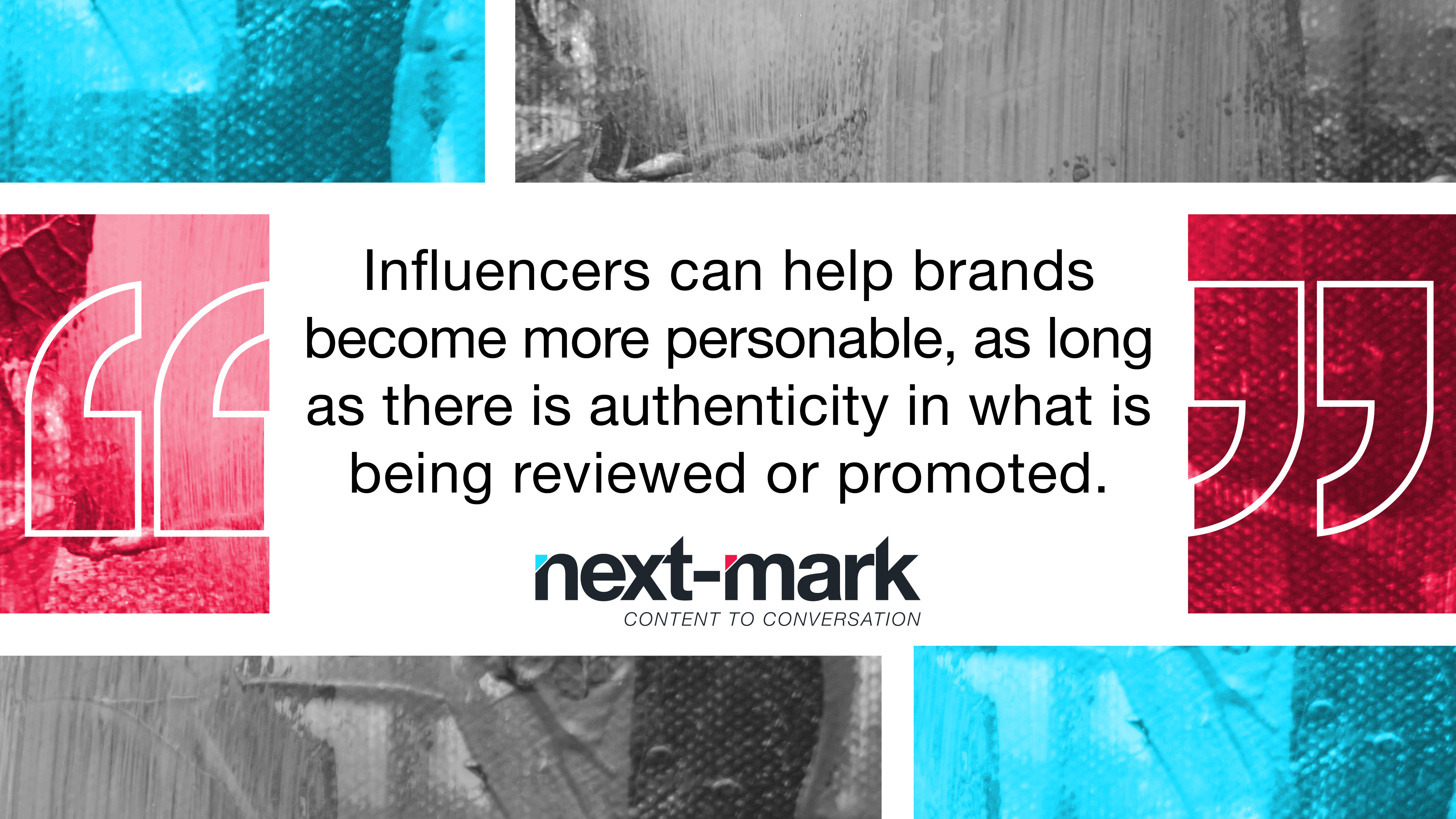
In recent years, a new form of marketing has emerged on the scene – influencer marketing. This is defined as the practice of building relationships with people who can then build relationships for you. Social media platforms such as YouTube, Instagram, and Facebook have helped develop and enable the success of influencer marketing. This blog explores the topic of influencer marketing and how it is impacting the marketing landscape.
In order to truly understand influencer marketing, we must first clearly define what an “influencer” is. An influencer is someone who has a strong connection with his or her audience. Influencers include: industry experts, bloggers, and micro influencers. Unlike celebrities, influencers are everywhere – they can be anyone. What makes influencers “influential” is their large following on social media and other digital platforms.
A large following gives influencers the power to affect the purchase decisions of others because of their knowledge, connection, or relationship with their audience. Influencers affect purchase decisions because consumers nowadays crave a more personal and authentic voice. Consumers are constantly bombarded with advertisements, and as a result, they feel more inclined to trust product and service reviews from influencers as they only promote products they feel strongly about. Since influencers have an authentic voice and the power to affect purchase decisions, brands are quickly turning to influencers in order to have them promote their products or services.
If your company does decide to use influencer marketing to promote its product or service, it’s important to remember to set goals. Also keep in mind influencer marketing doesn’t necessarily increase sales; it’s more about increasing public awareness and generating buzz around your brand. This is why it’s important to research and identify the kind of influencers a target audience listens to. It’s also important to note where people are connecting with influencers. Currently, Instagram seems to be the most popular platform for influencer marketing, as about 92% of influencers use Instagram as their number one platform. However, just because Instagram is at the top of list doesn’t mean brands should ignore influencers on other platforms. Each platform has its own niche audience it caters to.
The popularity of influencer marketing is quickly rising; big brands like Dove and Olay have used influencers to help launch comprehensive advertising campaigns. In such a competitive advertising market, it’s important not to over-saturate consumers with influencer advertisements. Influencers can help brands become more personable, as long as there is authenticity in what is being reviewed or promoted. A successful influencer campaign is about creating an authentic voice by finding the right platform and the right influencers.
Influencers have helped revolutionize advertising and marketing into something more authentic and personable. Influencer marketing may be a fairly new concept, but as social media and other digital platforms create more ways for influencers to reach their audiences, the demand in influencer marketing will only continue to increase. The partnership between brands and influencers has definitely become a forced to be reckoned with.

Are you considering an image refresh for your company? Rebranding can benefit organizations of all sizes, signifying evolution and intent. Whether you want to change the perception of your brand, attract a new audience or simply increase sales, make sure your efforts are strategic. Although image updates can be time-intensive and costly, if executed correctly your efforts will pay off in the long run. Before you rush into a rebrand, it’s important to ask yourself these questions:
Is your target market changing?
Stagnant sales often lead companies to turn their attention to new audiences, leading to a necessary image refresh. Old Spice is a great example of how rebranding can peak interest in a new demographic. Traditionally seen as a brand for older customers, Old Spice launched a marketing campaign featuring Isaiah Mustafa. The ads were amusing, quippy and somewhat strange — appealing to the humor of a much different generation. As a result, the campaign went viral, sales spiked and younger consumers began reaching for Old Spice.
Have your offerings expanded?
As your company grows, it will undoubtedly begin expanding its offerings to increase revenue. Does your current message and branding reflect this growth? Your image should evolve to demonstrate the company’s focus and inform both new and existing customers.
Does your aesthetic look outdated?
Consider the evolution of design in all aspects of society, from clothing styles to interior design trends. We even have a “color of the year” that inspires designers everywhere, until a new shade kicks it out of the top spot 12 months later. The point? Aesthetics change and your brand can quickly appear outdated if it doesn’t evolve. Consider Taco Bell’s growth from a logo sporting bright colors and exaggerated fonts to a more on-trend, minimal style. The company recognized that their brand was obsolete and opted for a refresh.
Will a rebrand fit into a larger strategic plan?
Rebranding is more than simply changing your logo. Take a critical look at your messaging, website, outreach, buyer persona, brand personality, internal communications strategy and organizational goals. These all have to align with your new visual strategy for a rebrand to be successful. Consistency across mediums and messaging is key!
So before you launch headfirst into a rebrand, do your research. Or better yet, let us do it for you! Give us a call to see if crafting a fresh identity is the right move your company.
